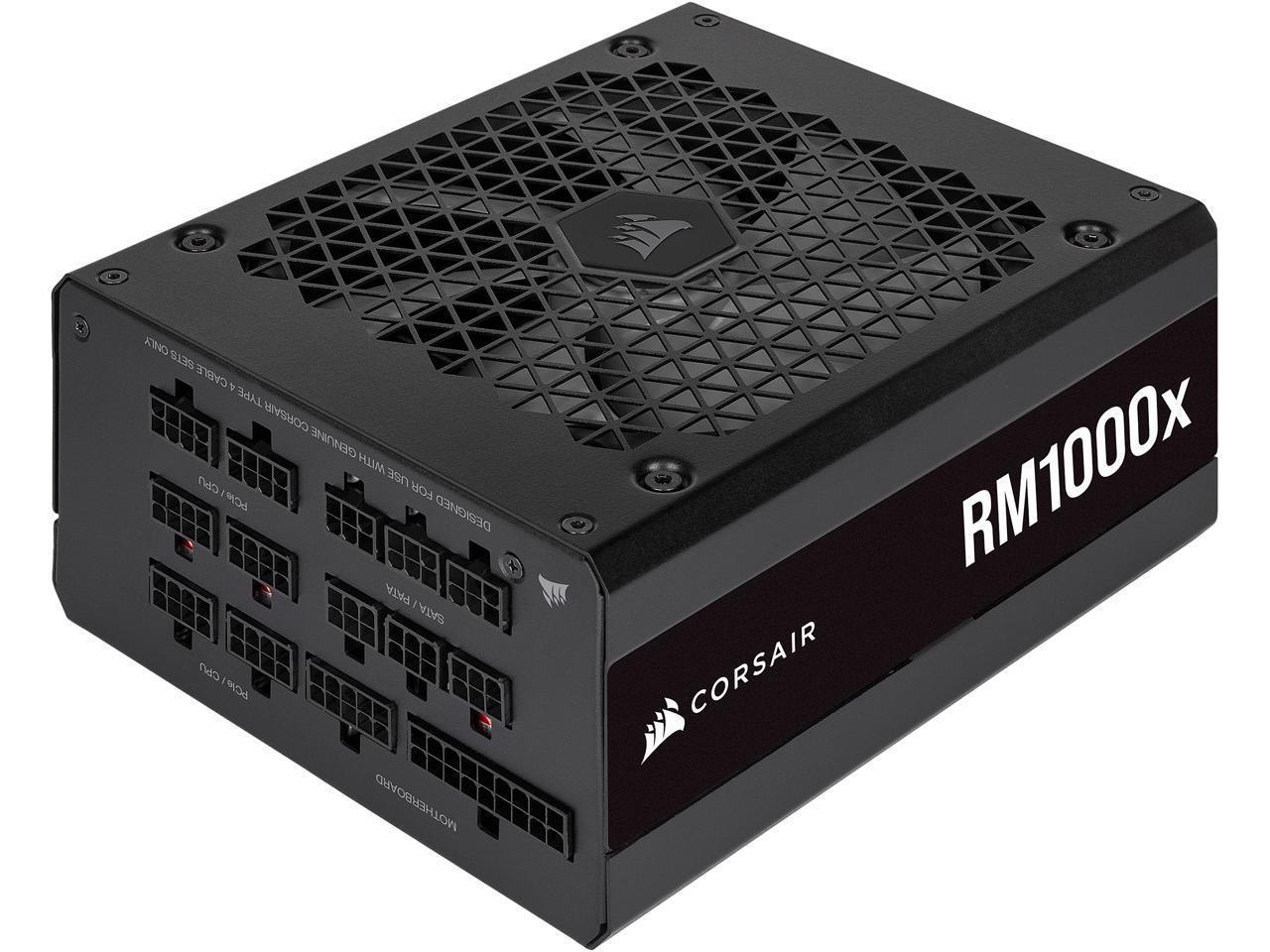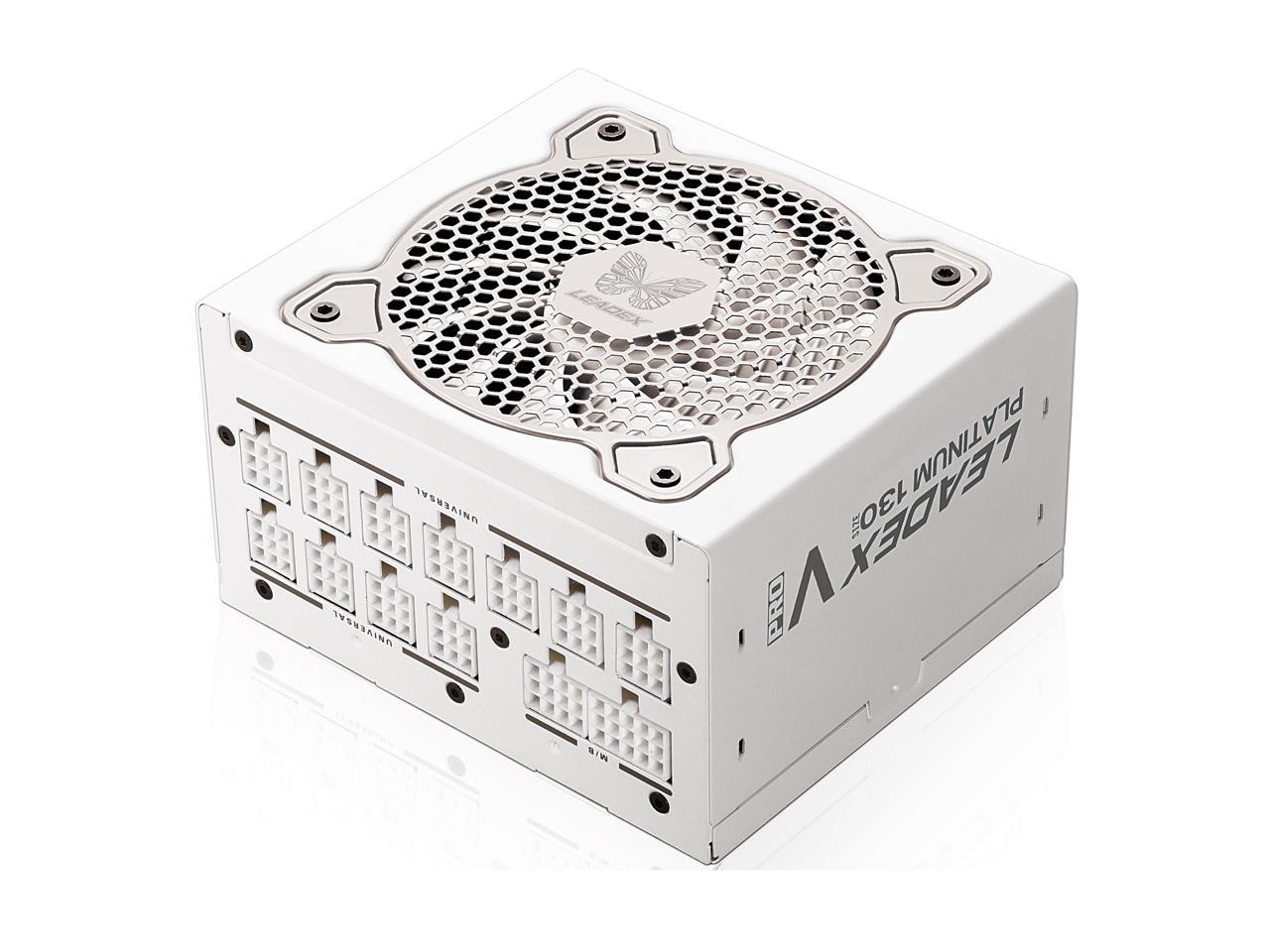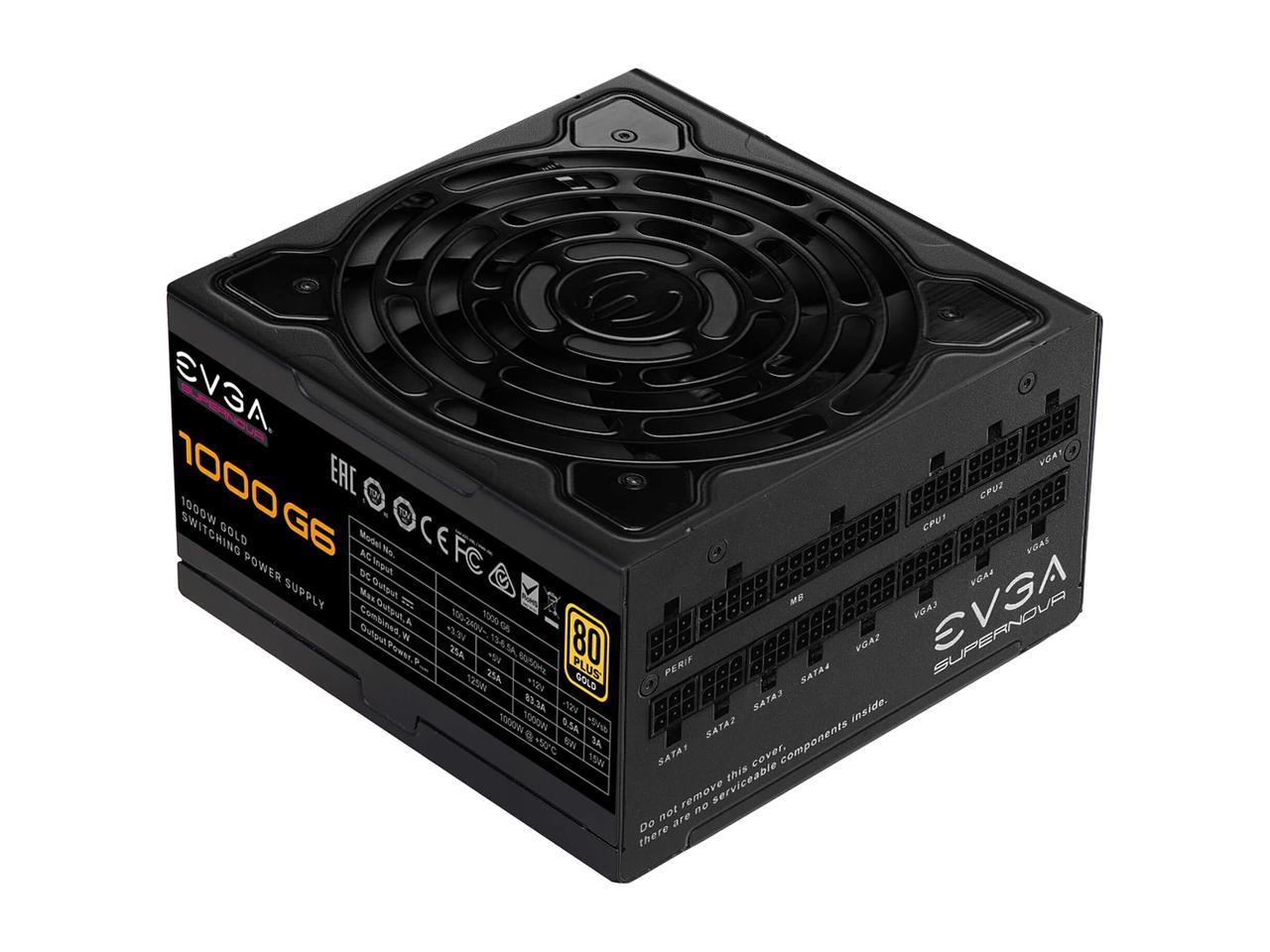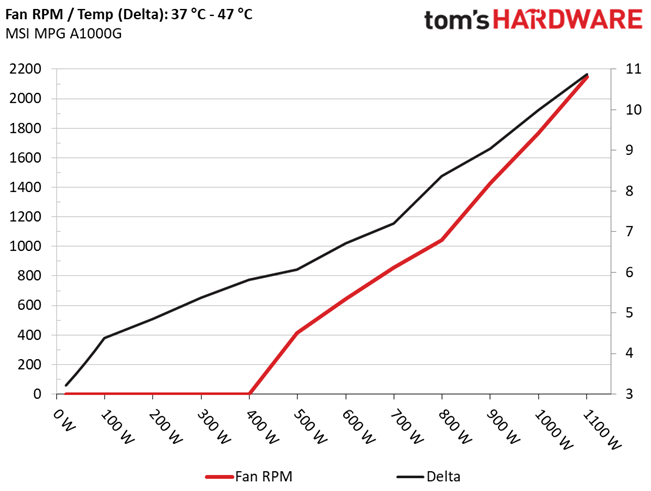Why you can trust Tom's Hardware
To learn more about our PSU tests and methodology, please check out How We Test Power Supply Units.
Primary Rails And 5VSB Load Regulation
The following charts show the main rails' voltage values recorded between a range of 40W up to the PSU's maximum specified load, along with the deviation (in percent). Tight regulation is an important consideration every time we review a power supply because it facilitates constant voltage levels despite varying loads. Tight load regulation also, among other factors, improves the system’s stability, especially under overclocked conditions and, at the same time, it applies less stress to the DC-DC converters that many system components utilize.

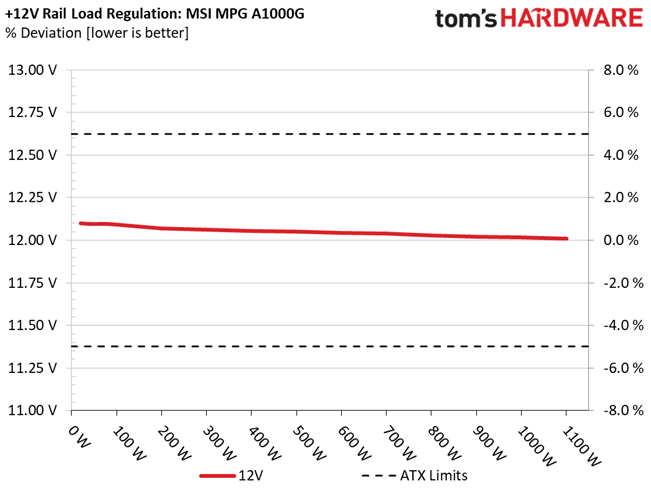
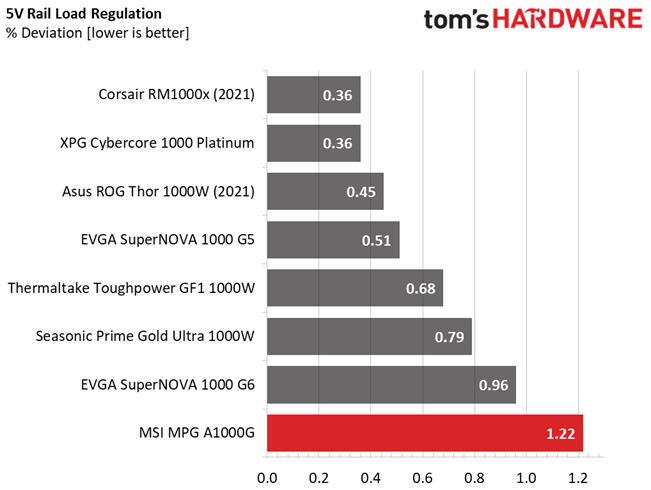

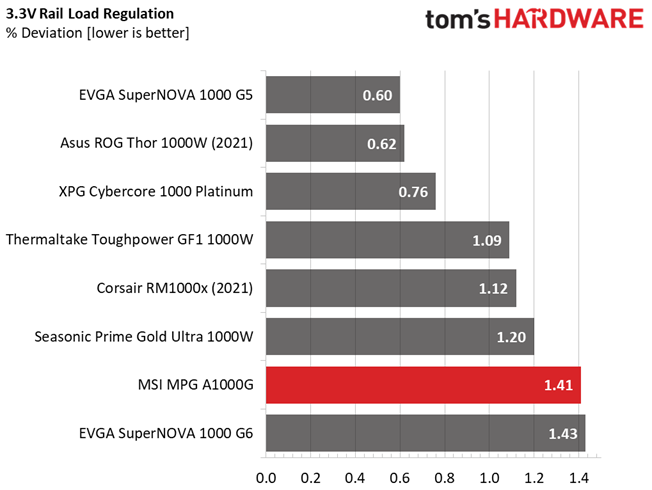
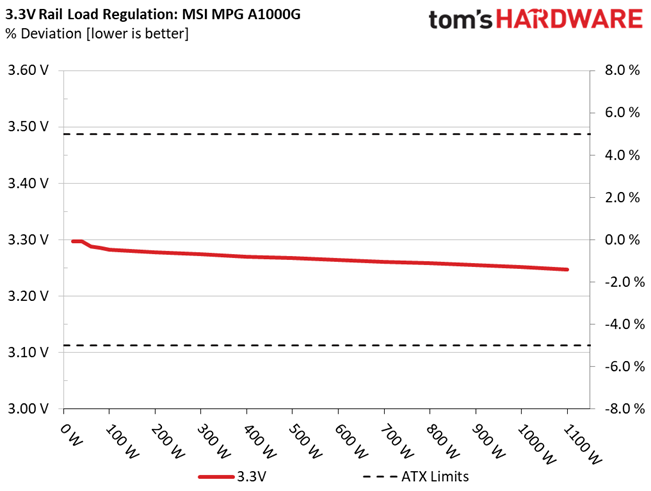

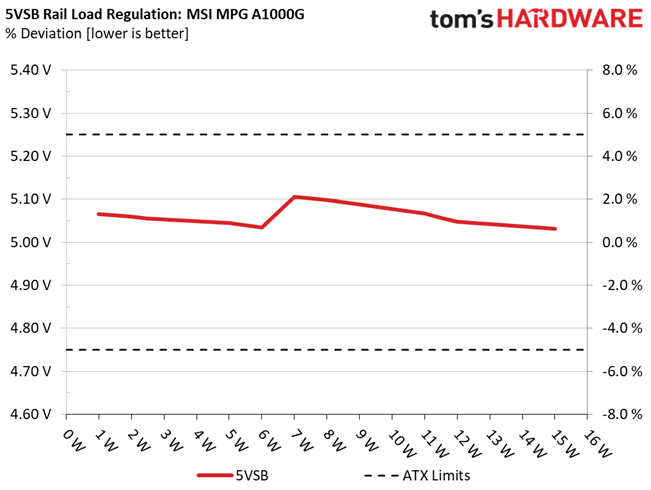
Load regulation is tight enough at 12V and pretty tight at 5VSB. On the 5V and 3.3V rails, the PSU doesn't meet the competition, though.
Hold-Up Time
Put simply; hold-up time is the amount of time that the system can continue to run without shutting down or rebooting during a power interruption.
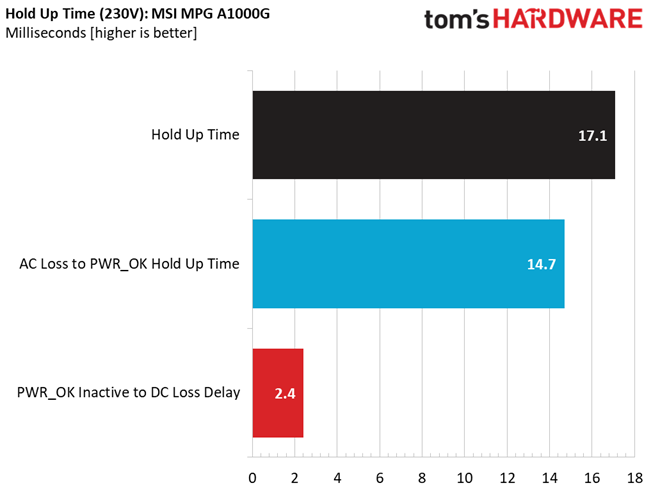
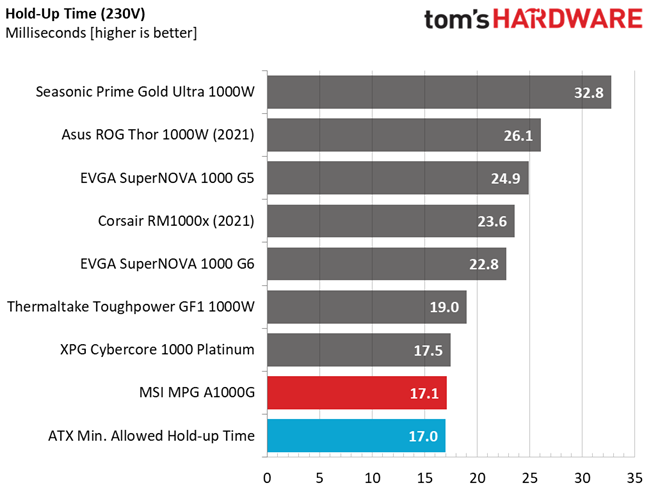
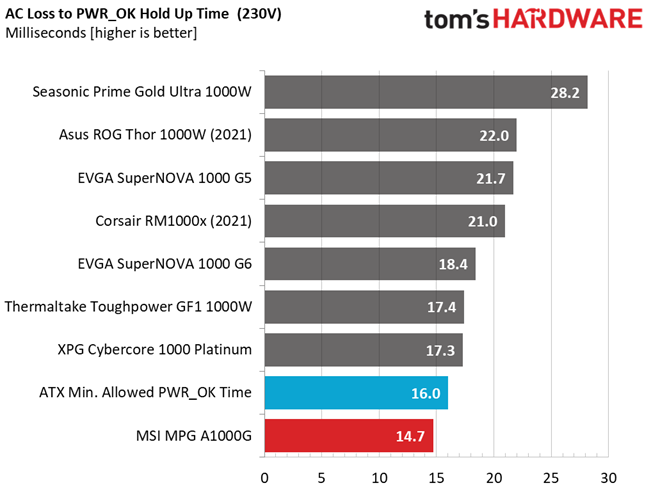
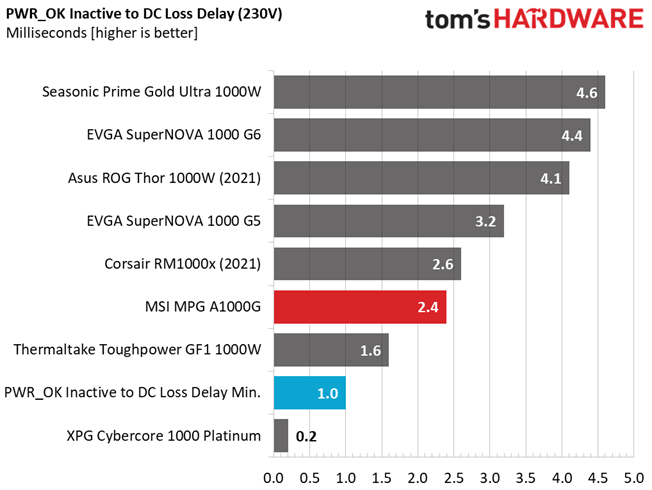
The hold-up time is slightly above 17ms, but the power ok signal's hold-up time doesn't reach 16ms.
Inrush Current
Inrush current, or switch-on surge, refers to the maximum, instantaneous input current drawn by an electrical device when it is first turned on. A large enough inrush current can cause circuit breakers and fuses to trip. It can also damage switches, relays, and bridge rectifiers. As a result, the lower the inrush current of a PSU right as it is turned on, the better.
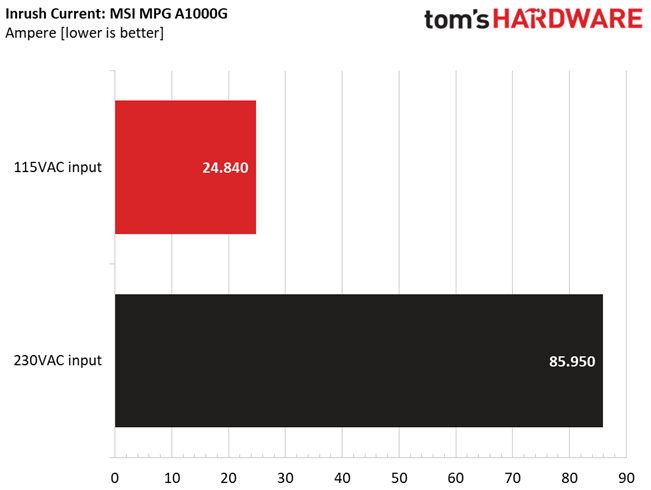
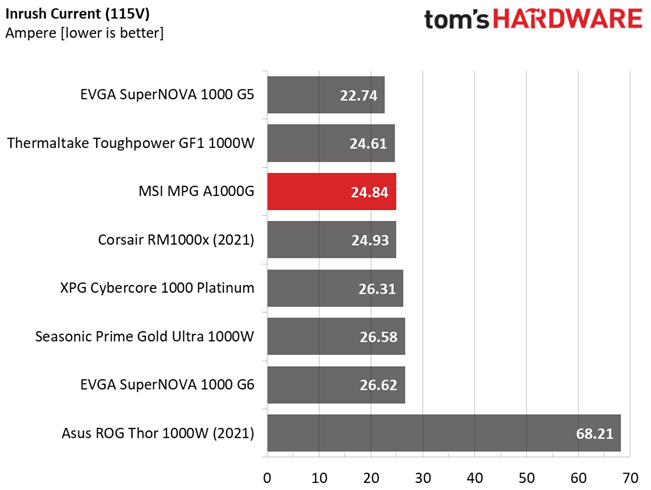
The inrush current is increased with 230V. A higher resistance NTC thermistor would help here.
Get Tom's Hardware's best news and in-depth reviews, straight to your inbox.
Leakage Current
In layman's terms, leakage current is the unwanted transfer of energy from one circuit to another. In power supplies, it is the current flowing from the primary side to the ground or the chassis, which in the majority of cases is connected to the ground. For measuring leakage current, we use a GW Instek GPT-9904 electrical safety tester instrument.
The leakage current test is conducted at 110% of the DUT's rated voltage input (so for a 230-240V device, we should conduct the test with 253-264V input). The maximum acceptable limit of a leakage current is 3.5 mA and it is defined by the IEC-60950-1 regulation, ensuring that the current is low and will not harm any person coming in contact with the power supply's chassis.
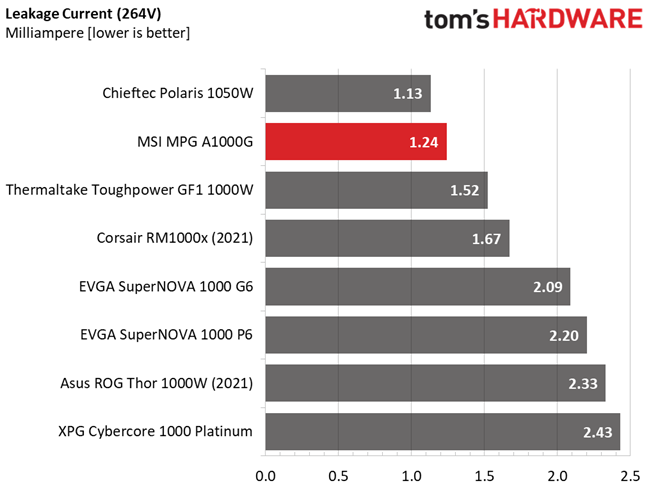
Leakage current is at normal levels.
10-110% Load Tests
These tests reveal the PSU's load regulation and efficiency levels under high ambient temperatures. They also show how the fan speed profile behaves under increased operating temperatures.
| Test | 12V | 5V | 3.3V | 5VSB | DC/AC (Watts) | Efficiency | Fan Speed (RPM) | PSU Noise (dB[A]) | Temps (In/Out) | PF/AC Volts |
| 10% | 6.483A | 1.993A | 2.011A | 0.991A | 100.005 | 86.193% | 0 | <6.0 | 44.97°C | 0.977 |
| Row 2 - Cell 0 | 12.094V | 5.018V | 3.282V | 5.045V | 116.025 | Row 2 - Cell 6 | Row 2 - Cell 7 | Row 2 - Cell 8 | 40.59°C | 115.16V |
| 20% | 14.007A | 2.993A | 3.021A | 1.192A | 199.962 | 90.913% | 0 | <6.0 | 45.89°C | 0.986 |
| Row 4 - Cell 0 | 12.069V | 5.013V | 3.277V | 5.034V | 219.949 | Row 4 - Cell 6 | Row 4 - Cell 7 | Row 4 - Cell 8 | 41.03°C | 115.16V |
| 30% | 21.881A | 3.494A | 3.528A | 1.371A | 300.013 | 91.562% | 0 | <6.0 | 46.83°C | 0.987 |
| Row 6 - Cell 0 | 12.063V | 5.009V | 3.274V | 5.105V | 327.66 | Row 6 - Cell 6 | Row 6 - Cell 7 | Row 6 - Cell 8 | 41.45°C | 115.16V |
| 40% | 29.732A | 3.997A | 4.037A | 1.569A | 399.679 | 91.333% | 0 | <6.0 | 47.43°C | 0.986 |
| Row 8 - Cell 0 | 12.057V | 5.004V | 3.27V | 5.099V | 437.604 | Row 8 - Cell 6 | Row 8 - Cell 7 | Row 8 - Cell 8 | 41.62°C | 115.15V |
| 50% | 37.253A | 5A | 5.051A | 1.769A | 499.432 | 90.775% | 416 | 7.5 | 42.34°C | 0.987 |
| Row 10 - Cell 0 | 12.051V | 5.001V | 3.267V | 5.088V | 550.188 | Row 10 - Cell 6 | Row 10 - Cell 7 | Row 10 - Cell 8 | 48.41°C | 115.15V |
| 60% | 44.842A | 6.004A | 6.067A | 1.97A | 599.952 | 90.06% | 643 | 18.1 | 42.49°C | 0.989 |
| Row 12 - Cell 0 | 12.045V | 4.998V | 3.264V | 5.078V | 666.168 | Row 12 - Cell 6 | Row 12 - Cell 7 | Row 12 - Cell 8 | 49.2°C | 115.14V |
| 70% | 52.377A | 7.009A | 7.085A | 2.171A | 699.692 | 89.206% | 854 | 27.2 | 43.77°C | 0.991 |
| Row 14 - Cell 0 | 12.039V | 4.995V | 3.261V | 5.067V | 784.353 | Row 14 - Cell 6 | Row 14 - Cell 7 | Row 14 - Cell 8 | 50.97°C | 115.14V |
| 80% | 60.001A | 8.002A | 8.103A | 2.274A | 799.652 | 88.422% | 1041 | 33.1 | 43.96°C | 0.992 |
| Row 16 - Cell 0 | 12.030V | 4.992V | 3.258V | 5.057V | 904.361 | Row 16 - Cell 6 | Row 16 - Cell 7 | Row 16 - Cell 8 | 52.32°C | 115.14V |
| 90% | 67.959A | 8.522A | 8.602A | 2.377A | 899.506 | 87.501% | 1427 | 42.4 | 44.5°C | 0.993 |
| Row 18 - Cell 0 | 12.023V | 4.988V | 3.255V | 5.048V | 1027.993 | Row 18 - Cell 6 | Row 18 - Cell 7 | Row 18 - Cell 8 | 53.55°C | 115.14V |
| 100% | 75.722A | 9.031A | 9.133A | 2.982A | 999.504 | 86.457% | 1767 | 48.1 | 45.63°C | 0.994 |
| Row 20 - Cell 0 | 12.016V | 4.983V | 3.251V | 5.031V | 1156.079 | Row 20 - Cell 6 | Row 20 - Cell 7 | Row 20 - Cell 8 | 55.62°C | 115.14V |
| 110% | 83.431A | 10.043A | 10.254A | 2.987A | 1100.15 | 85.091% | 2149 | 52.8 | 46.69°C | 0.995 |
| Row 22 - Cell 0 | 12.008V | 4.978V | 3.247V | 5.022V | 1292.906 | Row 22 - Cell 6 | Row 22 - Cell 7 | Row 22 - Cell 8 | 57.56°C | 115.14V |
| CL1 | 0.116A | 14.407A | 14.621A | 0A | 121.298 | 84.076% | 560 | 13.2 | 43.23°C | 0.986 |
| Row 24 - Cell 0 | 12.097V | 5.011V | 3.262V | 5.042V | 144.271 | Row 24 - Cell 6 | Row 24 - Cell 7 | Row 24 - Cell 8 | 48.43°C | 115.18V |
| CL2 | 0.115A | 21.846A | 0A | 0A | 111.39 | 82.211% | 868 | 27.8 | 41.61°C | 0.981 |
| Row 26 - Cell 0 | 12.101V | 5.035V | 3.276V | 5.055V | 135.494 | Row 26 - Cell 6 | Row 26 - Cell 7 | Row 26 - Cell 8 | 48.69°C | 115.17V |
| CL3 | 0.115A | 0A | 22.242A | 0A | 73.988 | 75.94% | 940 | 30.3 | 40.18°C | 0.977 |
| Row 28 - Cell 0 | 12.095V | 5.008V | 3.264V | 5.042V | 97.43 | Row 28 - Cell 6 | Row 28 - Cell 7 | Row 28 - Cell 8 | 49.29°C | 115.17V |
| CL4 | 83.215A | 0A | 0A | 0A | 1000.08 | 87.244% | 1504 | 43.9 | 42.62°C | 0.994 |
| Row 30 - Cell 0 | 12.018V | 5.005V | 3.272V | 5.094V | 1146.31 | Row 30 - Cell 6 | Row 30 - Cell 7 | Row 30 - Cell 8 | 54.03°C | 115.13V |
No problems in full power delivery under tough conditions, but efficiency takes a hit and the cooling fan has to spin at high speeds, so it makes a loud noise.
20-80W Load Tests
In the following tests, we measure the PSU's efficiency at loads significantly lower than 10% of its maximum capacity (the lowest load the 80 PLUS standard measures). This is important for representing when a PC is idle with power-saving features turned on.
| Test | 12V | 5V | 3.3V | 5VSB | DC/AC (Watts) | Efficiency | Fan Speed (RPM) | PSU Noise (dB[A]) | Temps (In/Out) | PF/AC Volts |
| 20W | 1.228A | 0.496A | 0.5A | 0.197A | 19.999 | 49.037% | 0 | <6.0 | 40.07°C | 0.932 |
| Row 2 - Cell 0 | 12.099V | 5.044V | 3.297V | 5.065V | 40.783 | Row 2 - Cell 6 | Row 2 - Cell 7 | Row 2 - Cell 8 | 36.85°C | 115.17V |
| 40W | 2.702A | 0.694A | 0.701A | 0.296A | 39.997 | 76.284% | 0 | <6.0 | 41.29°C | 0.959 |
| Row 4 - Cell 0 | 12.097V | 5.043V | 3.297V | 5.062V | 52.432 | Row 4 - Cell 6 | Row 4 - Cell 7 | Row 4 - Cell 8 | 37.81°C | 115.16V |
| 60W | 4.176A | 0.895A | 0.903A | 0.395A | 59.996 | 81.677% | 0 | <6.0 | 41.78°C | 0.968 |
| Row 6 - Cell 0 | 12.097V | 5.029V | 3.288V | 5.059V | 73.455 | Row 6 - Cell 6 | Row 6 - Cell 7 | Row 6 - Cell 8 | 38.02°C | 115.16V |
| 80W | 5.648A | 1.095A | 1.105A | 0.495A | 79.952 | 85.456% | 0 | <6.0 | 43.55°C | 0.977 |
| Row 8 - Cell 0 | 12.095V | 5.022V | 3.285V | 5.055V | 93.559 | Row 8 - Cell 6 | Row 8 - Cell 7 | Row 8 - Cell 8 | 39.49°C | 115.16V |
Efficiency is bottom low with 20W, and we would like to see over 80% with 40W load.
2% or 10W Load Test
From July 2020, the ATX spec requires 70% and higher efficiency with 115V input. The applied load is only 10W for PSUs with 500W and lower capacities, while for stronger units, we dial 2% of their max-rated capacity.
| 12V | 5V | 3.3V | 5VSB | DC/AC (Watts) | Efficiency | Fan Speed (RPM) | PSU Noise (dB[A]) | Temps (In/Out) | PF/AC Volts |
| 1.472A | 0.255A | 0.255A | 0.053A | 20.199 | 50.084% | 0 | <6.0 | 32.45°C | 0.932 |
| Row 2 - Cell 0 | 12.094V | 5.044V | 3.297V | 5.068V | 40.33 | Row 2 - Cell 6 | Row 2 - Cell 7 | 31.46°C | 115.17V |
Efficiency with 2% load is too low. It should be above 60% and ideally above 70%.
Efficiency & Power Factor
Next, we plotted a chart showing the PSU's efficiency at low loads and loads from 10 to 110% of its maximum rated capacity. The higher a PSU’s efficiency, the less energy goes wasted, leading to a reduced carbon footprint and lower electricity bills. The same goes for Power Factor.
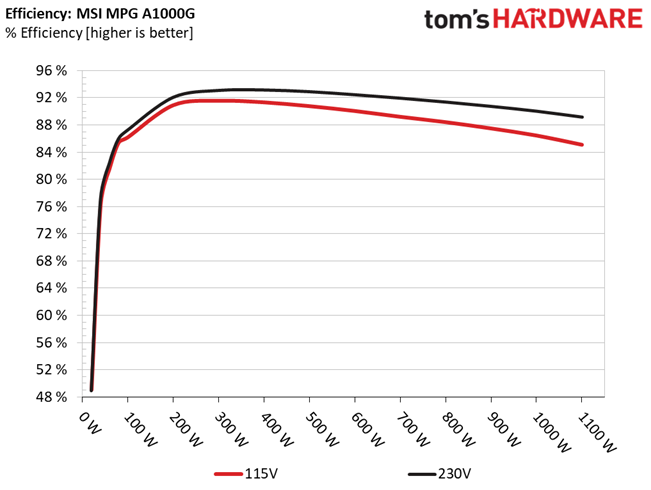
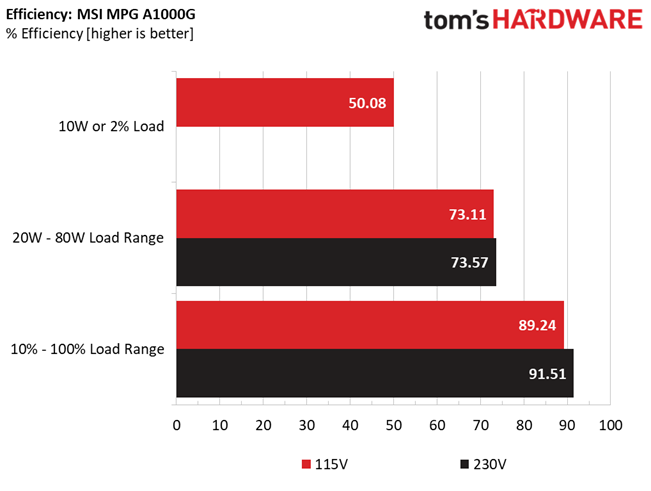
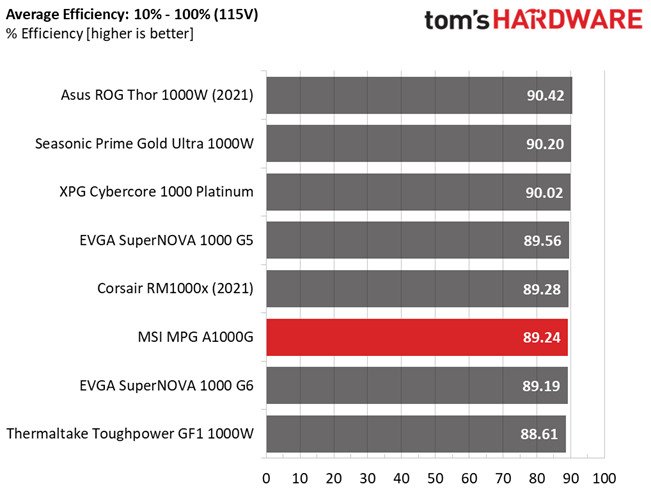

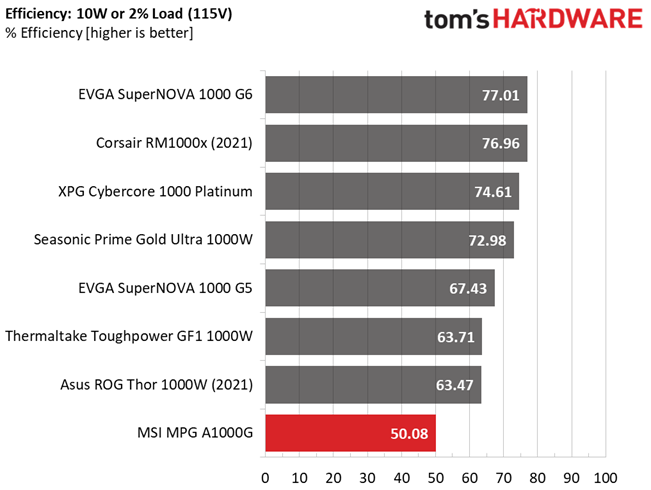

Efficiency is high enough with normal loads, but low with light loads and bottom load with super-light loads.
5VSB Efficiency
| Test # | 5VSB | DC/AC (Watts) | Efficiency | PF/AC Volts |
| 1 | 0.1A | 0.507W | 76.499% | 0.065 |
| Row 2 - Cell 0 | 5.069V | 0.663W | Row 2 - Cell 3 | 115.16V |
| 2 | 0.25A | 1.267W | 78.796% | 0.147 |
| Row 4 - Cell 0 | 5.066V | 1.608W | Row 4 - Cell 3 | 115.16V |
| 3 | 0.55A | 2.785W | 79.512% | 0.259 |
| Row 6 - Cell 0 | 5.061V | 3.503W | Row 6 - Cell 3 | 115.17V |
| 4 | 1A | 5.055W | 79.438% | 0.347 |
| Row 8 - Cell 0 | 5.054V | 6.363W | Row 8 - Cell 3 | 115.17V |
| 5 | 1.5A | 7.57W | 79.819% | 0.396 |
| Row 10 - Cell 0 | 5.045V | 9.484W | Row 10 - Cell 3 | 115.17V |
| 6 | 3A | 15.063W | 78.297% | 0.46 |
| Row 12 - Cell 0 | 5.021V | 19.239W | Row 12 - Cell 3 | 115.16V |


The 5VSB rail is not efficient.
Power Consumption In Idle And Standby
| Mode | 12V | 5V | 3.3V | 5VSB | Watts | PF/AC Volts |
| Idle | 12.079V | 5.045V | 3.299V | 5.07V | 4.14 | 0.35 |
| Row 2 - Cell 0 | Row 2 - Cell 1 | Row 2 - Cell 2 | Row 2 - Cell 3 | Row 2 - Cell 4 | Row 2 - Cell 5 | 115.17V |
| Standby | Row 3 - Cell 1 | Row 3 - Cell 2 | Row 3 - Cell 3 | Row 3 - Cell 4 | 0.025 | 0.002 |
| Row 4 - Cell 0 | Row 4 - Cell 1 | Row 4 - Cell 2 | Row 4 - Cell 3 | Row 4 - Cell 4 | Row 4 - Cell 5 | 115.17V |
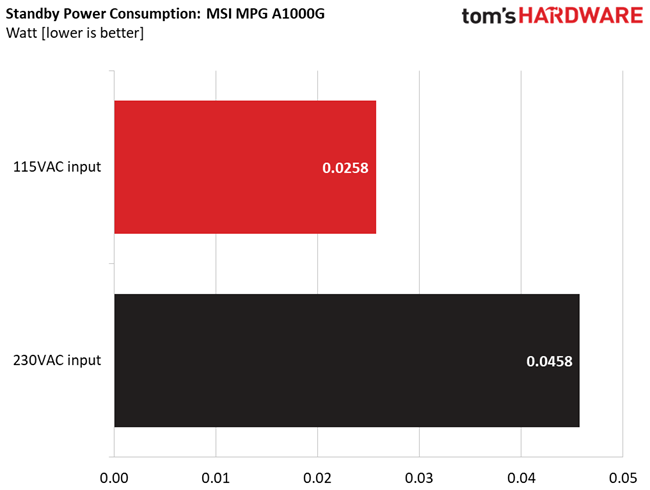

Vampire power is low and this is good, of course, since it means that the PSU has minimized energy needs in standby.
Fan RPM, Delta Temperature, And Output Noise
All results are obtained between an ambient temperature of 37 to 47 degrees Celsius (98.6 to 116.6 degrees Fahrenheit).
The fan speed profile is linear, but due to the compact dimensions of the populated PCB, it applies high speeds at increased loads, which impacts noise output.
The following results were obtained at 30 to 32 degrees Celsius (86 to 89.6 degrees Fahrenheit) ambient temperature.
At normal operating temperatures, close to 30 degrees Celsius, the PSU is silent up to 600W loads. The 30 dBA mark is passed at around 740W and the noisy operating starts with 940W.
MORE: Best Power Supplies
MORE: How We Test Power Supplies
MORE: All Power Supply Content
Current page: Load Regulation, Hold-Up Time, Inrush & Leakage Current, Efficiency and Noise
Prev Page Specifications and Part Analysis Next Page Protection Features, DC Power Sequencing, Cross-Load Tests and Infrared Images
Aris Mpitziopoulos is a contributing editor at Tom's Hardware, covering PSUs.
-
vinay2070 Would AIBs be using the 12 pin GPU connectors for Ada? Or is it just nvidia reference cards? I read that Radeon cards will stick to the existing 8 pin connectors.Reply -
dk382 Thank you for the review. I've been looking at ATX 3.0/PCIe 5.0 power supplies, and I assume this one is very similar to the A1000G version with the new PCIe 5 connector that's available for $200.Reply
I face palmed when I first saw the fan grill on that PSU, came here, and was completely unsurprised to find that it's a little noisy. How much quieter would it be if it just had a normal fan grill instead of all that metal that's currently blocking the fan? What's the point of such a stylized design if it's just gonna be face-down in a PSU shroud anyway? All it's doing is adding unnecessary impedence when combined with your case's own PSU fan grill and dust filter.
